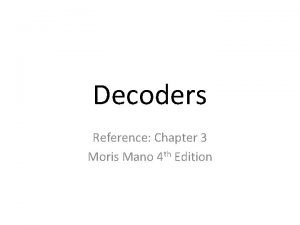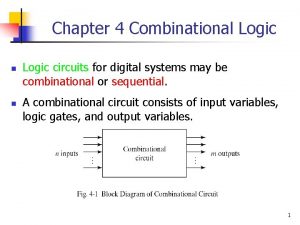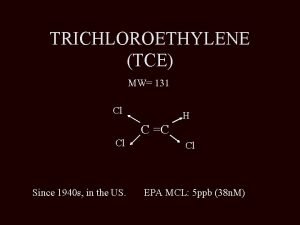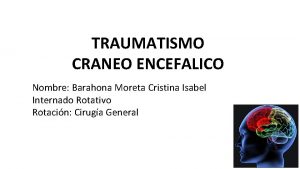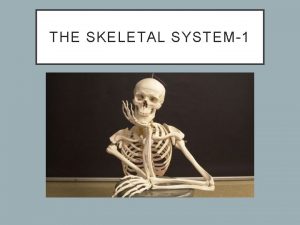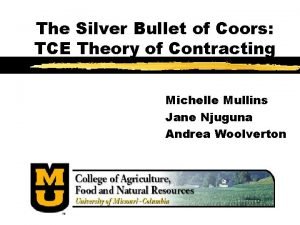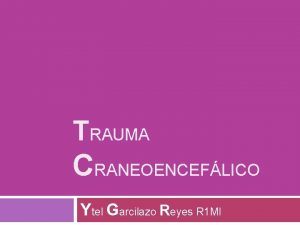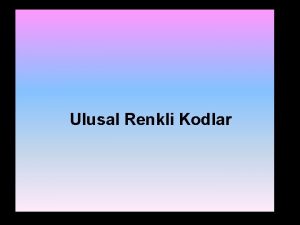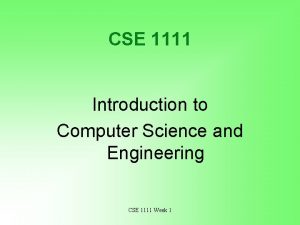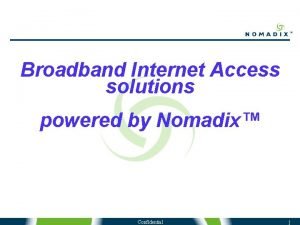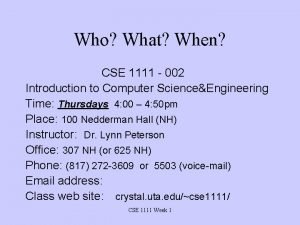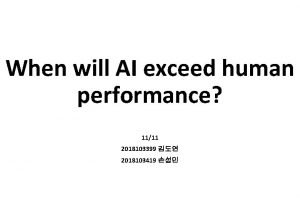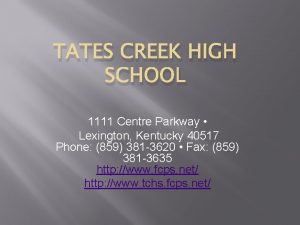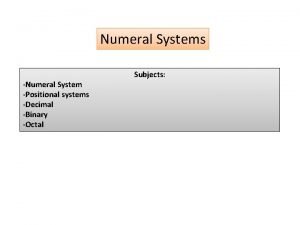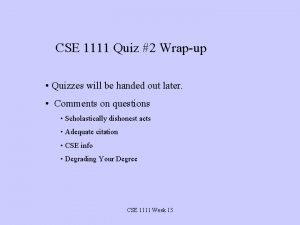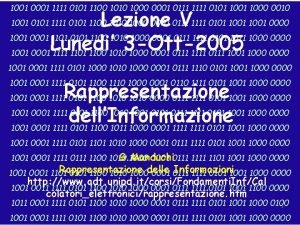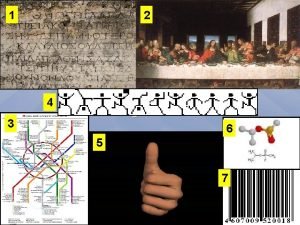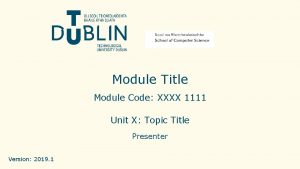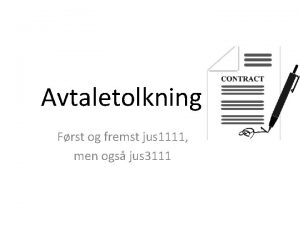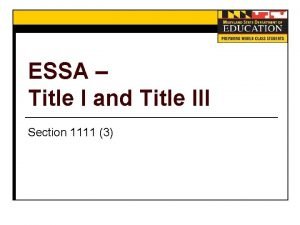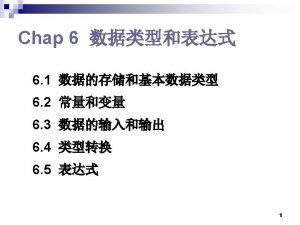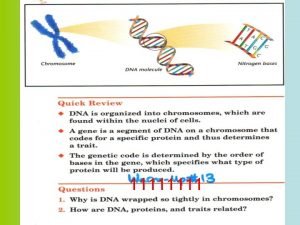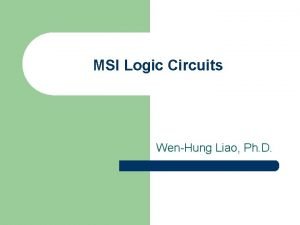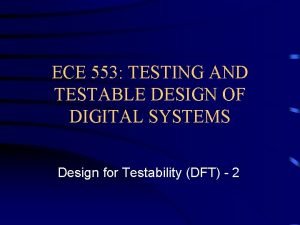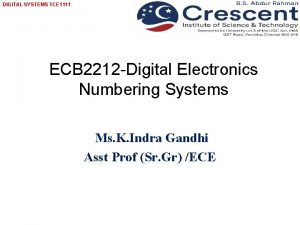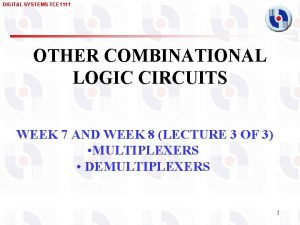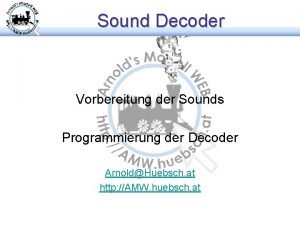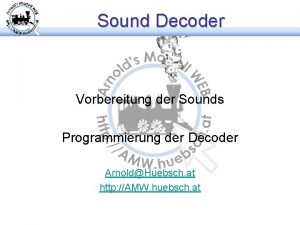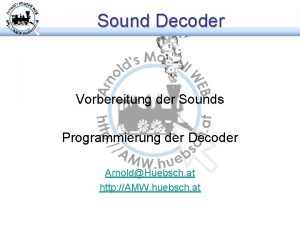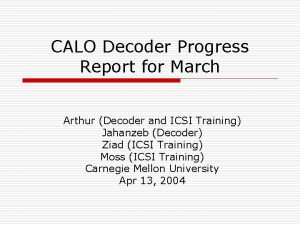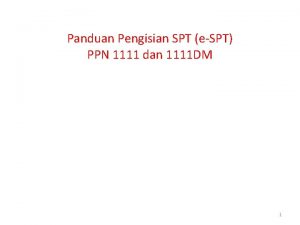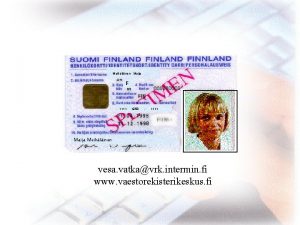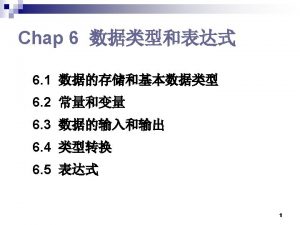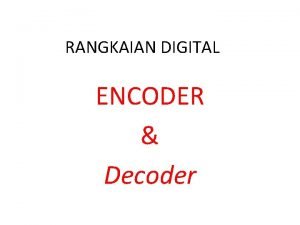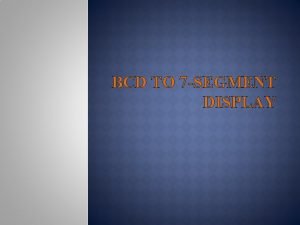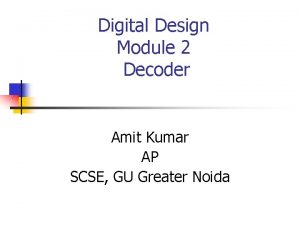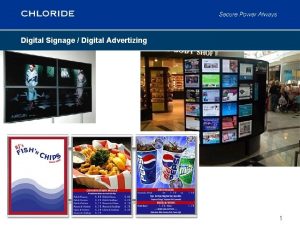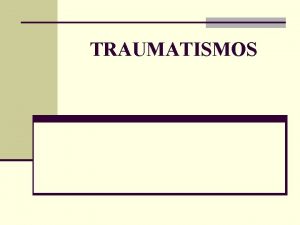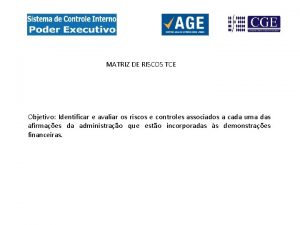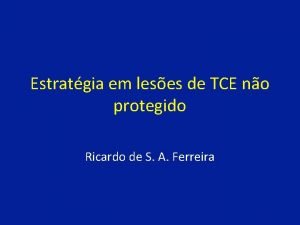DIGITAL SYSTEMS TCE 1111 DECODER A decoder is





































- Slides: 37

DIGITAL SYSTEMS TCE 1111 DECODER • A decoder is a logic circuit that accepts a set of inputs that represents a binary number and activates only the output that corresponds to the input number. • In other words, a decoder circuit looks at its inputs, determines which binary number is present there, and activates the one output that corresponds to that number ; all other outputs remain inactive 1

DIGITAL SYSTEMS TCE 1111 In its general form, a decoder has N input lines to handle N bits and form one to 2 N output lines to indicate the presence o one or more N-bit combinations. The basic binary function • An AND gate can be used as the basic decoding element because it produces a HIGH output only when all inputs are HIGH Refer next slide for example 2

DIGITAL SYSTEMS TCE 1111 Decoding logic for the binary code 1001 with an active-HIGH output. 3

DIGITAL SYSTEMS TCE 1111 General decoder diagram # There are 2 N possible input combinations, from A 0 to AN 1. For each of these input combinations only one of the M outputs will be active HIGH (1), all the other outputs are LOW (0). 4

DIGITAL SYSTEMS TCE 1111 2 -to-4 -Line Decoder (with Enable input)-Active LOW output (2) • The circuit operates with complemented outputs and a complement enable input. The decoder is enabled when E is equal to 0. • Only one output can be equal to 0 at any given time, all other outputs are equal to 1. • The output whose value is equal to 0 represents the minterm selected by inputs A and B • The circuit is disabled when E is equal to 1. 5

DIGITAL SYSTEMS TCE 1111 3 -8 line decoder (active-HIGH) 6

DIGITAL SYSTEMS TCE 1111 • This decoder can be referred to in several ways. It can be called a 3 -line-to- 8 -line decoder, because it has three input lines and eight output lines. • It could also be called a binary-octal decoder or converters because it takes a three bit binary input code and activates the one of the eight outputs corresponding to that code. It is also referred to as a 1 -of-8 decoder, because only 1 of the 8 outputs is activated at one time. 7

DIGITAL SYSTEMS TCE 1111 74138 (Example of a 3 8 Bit Decoder) • There is an enable function on this device, a LOW level on each input E’ 1, and E’ 2, and a HIGH level on input E 3, is required in order to make the enable gate output HIGH. • The enable is connected to an input of each NAND gate in the decoder, so it must be HIGH for the NAND gate to be enabled. • If the enable gate is not activated then all eight decoder outputs will be HIGH regardless of the states of the three input variables A 0, A 1, and A 2. 8

DIGITAL SYSTEMS TCE 1111 Logic symbol for a 4 -line-to-16 -line (1 -of-16) decoder. 74 HC 154 9

DIGITAL SYSTEMS TCE 1111 4 -line-to-16 line Decoder constructed with two 3 -lineto-8 line decoders (1). . . 10

DIGITAL SYSTEMS TCE 1111 4 -line-to-16 line Decoder constructed with two 3 -lineto-8 line decoders (2) • When w=0, the top decoder is enabled and the other is disabled. The bottom decoder outputs are all 0’s , and the top eight outputs generate min-terms 0000 to 0111. • When w=1, the enable conditions are reversed. The bottom decoder outputs generate min-terms 1000 to 1111, while the outputs of the top decoder are all 0’s. 11

DIGITAL SYSTEMS TCE 1111 Application example A simplified computer I/O port system with a port address decoder with only four address lines shown. 12

DIGITAL SYSTEMS TCE 1111 • Decoders are used in many types of applications. One example is in computers for I/O selection as in previous slide • Computer must communicate with a variety of external devices called peripherals by sending and/or receiving data through what is known as input/output (I/O) ports • Each I/O port has a number, called an address, which uniquely identifies it. When the computer wants to communicate with a particular device, it issues the appropriate address code for the I/O port to which that particular device is connected. The binary port address is decoded and appropriate decoder output is activated to enable the I/O port • Binary data are transferred within the computer on a data bus, which is 13 a set of parallel lines

DIGITAL SYSTEMS TCE 1111 BCD -to- Decimal decoders • The BCD- to-decimal decoder converts each BCD code into one of Ten Positionable decimal digit indications. It is frequently referred as a 4 -line -to- 10 line decoder • The method of implementation is that only ten decoding gates are required because the BCD code represents only the ten decimal digits 0 through 9. • Each of these decoding functions is implemented with NAND gates to provide active -LOW outputs. If an active HIGH output is required, AND gates are used for decoding 14

DIGITAL SYSTEMS TCE 1111 Logic diagram of BCD - decimal decoder (Active LOW output) 15

DIGITAL SYSTEMS TCE 1111 Output Waveform for BCD Decoder 16

DIGITAL SYSTEMS TCE 1111 A Decoder Application - Counter -decoder combination used to provide timing and sequential operations (1). . . 17

DIGITAL SYSTEMS TCE 1111 A Decoder Application - Counter -decoder combination used to provide timing and sequential operations (1). . . • Decoders are used whenever an output or a group of outputs is to be activated only on the occurrence of specific combination of input levels. These input levels are often provided by the outputs of a counter or register. • When the decoder inputs come from a counter that is being continually pulsed, the decoder outputs will be activated sequentially, and there can be used as timing or sequencing signals to turn device on or off at specific times 18

DIGITAL SYSTEMS TCE 1111 BCD-7 segment decoders/drivers Most digital equipment has some means for displaying information in a form that can be understood by the user. This information is often numerical data but also be alphanumeric. One of the simplest and most popular methods for displaying numerical digits uses a 7 -segment configuration to form digital characters 0 to 9 and some times the hex characters A to F 19

DIGITAL SYSTEMS TCE 1111 One common arrangements uses light-emitting diodes (LED's) for each segment. By controlling the current thru each LED, some segments will be light and others will be dark so that desired character pattern will be generated Figure shows the segment pattern that are used to display the various digits. For example, to display a “ 6” the segments a, c, d, e, f and g are made bright while segment b is dark 20

DIGITAL SYSTEMS TCE 1111 7 -segment decoder • A BCD-7 segment decoder/driver is used to take four-bit BCD input and provide the outputs that will pass current through the appropriate segments to display the decimal digit. • The logic for this decoder is more complicated than the logic of decoders of earlier case, because each output is activated for more than one combination of inputs. 21

DIGITAL SYSTEMS TCE 1111 74 LS 47 ( BCD to Seven Segment Decoder) 22

DIGITAL SYSTEMS TCE 1111 23

DIGITAL SYSTEMS TCE 1111 Common Cathode • In common cathode, the cathode of all of the LEDs are tied together to ground as shown. GND 24

DIGITAL SYSTEMS TCE 1111 Combinational Logic Circuit Implementation using a Decoder • Any combinational logic circuit with n inputs and m outputs can be implemented with an n-to-2 n-line decoder and m OR gates. • Procedure: – Express the given Boolean function in sum of min-terms – Choose a decoder to generate all the min-terms of the input variables. – Select the inputs to each OR gate from the decoder outputs according to the list of min-term for each function. 25

DIGITAL SYSTEMS TCE 1111 Combinational Logic Circuit Implementation using a Decoder - An example (1) • From the truth table of the full adder, x y Z C S 0 0 0 0 1 0 1 0 1 1 1 0 0 0 1 1 0 1 1 1 • the functions can be expressed in sum of min-terms. S(x, y, z) = m(1, 2, 4, 7) C(x, y, z) = m(3, 5, 6, 7) where indicates sum, m indicates min-term and the number in brackets indicate the decimal equivalent 26

DIGITAL SYSTEMS TCE 1111 Combinational Logic Circuit Implementation using a Decoder - An example (2) Since there are three inputs and a total of eight min-terms, we need a 3 -to-8 line decoder. • The decoder generates the eight min-terms for x, y, z • The OR gate for output S forms the logical sum of min-terms 1, 2, 4, and 7. • The OR gates for output C forms the logical sum of min-terms 3, 5, 6, and 7 27

DIGITAL SYSTEMS TCE 1111 Combinational Logic Circuit Implementation using a Decoder - example (3) Implementation of a Full Adder with a Decoder 28

DIGITAL SYSTEMS TCE 1111 Encoder • An encoder is a combinational logic circuit that essentially performs a “reverse” of decoder functions. • An encoder accepts an active level on one of its inputs, representing digit, such as a decimal or octal digits, and converts it to a coded output such as BCD or binary. • Encoders can also be devised to encode various symbols and alphabetic characters. • The process of converting from familiar symbols or numbers to a coded format is called encoding. 29

DIGITAL SYSTEMS TCE 1111 • Most decoders accept an input code and produce a HIGH • ( or a LOW) at one and only one output line. In otherworlds , a decoder identifies, recognizes, or detects a particular code. The opposite of this decoding process is called encoding and is performed by a logic circuit called an encoder. • An encoder has a number of input lines, only one of which input is activated at a given time and produces an N-bit output code, depending on which input is activated. 30

DIGITAL SYSTEMS TCE 1111 General encoder diagram 31

DIGITAL SYSTEMS TCE 1111 Logic circuit for octal-to binary encoder [8 line- 3 -line ] 32

DIGITAL SYSTEMS TCE 1111 Truth table for octal-to binary encoder [8 -line- 3 -line ] A low at any single input will produce the output binary code corresponding to that input. For instance , a low at A 3’ will produce O 2 =0, O 1=1 and O 0 =1, which is binary code for 3. Ao’ is not connected to the logic gates because the encoder outputs always be normally at 0000 when none of the inputs is LOW 33

DIGITAL SYSTEMS TCE 1111 Design of 4 -input Priority Encoder ( 4 -line-to 2 line priority encoder) (1). . . • A priority encoder is an encoder that includes the priority function • If two or more inputs are equal to 1 at the same time, the input having the highest priority will take precedence. • Truth Table of a 4 -input Priority Encoder: Inputs Outputs D 0 D 1 D 2 D 3 x y V 0 0 X X 0 1 0 0 0 1 X 1 0 0 0 1 1 X X 1 0 1 X X X 1 1 34

DIGITAL SYSTEMS TCE 1111 Design of 4 -input Priority Encoder ( 4 -line-to 2 line priority encoder) (2). . . • In addition to two outputs x, and y, the truth table has a third output designated by V, which is a valid bit indicator that is set 1 when one or more inputs are equal to 1. If all inputs are 0, there is no valid input and V is equal to 0. • X’s in the output column indicate don’t care conditions, the X’s in the input columns are useful for representing a truth table in condensed form. • The higher the subscript number, the higher the priority of the input. Input D 3 has the highest priority, so regardless of the values of the other inputs, when this input is 1, the output for xy is 11 (binary 3) 35

DIGITAL SYSTEMS TCE 1111 Design of 4 -input Priority Encoder ( 4 -line-to 2 line priority encoder) (3). . . V=D 0+D 1+D 2+D 3 K-Maps for 4 -input Priority Encoder 36

DIGITAL SYSTEMS TCE 1111 The 16 to 4 Encoder 37
 4 input decoder
4 input decoder For a three variable combinational circuits, m(1,4,7)=
For a three variable combinational circuits, m(1,4,7)= Tce mw
Tce mw Tce
Tce Tce
Tce Tce theory
Tce theory Tucson tce contamination map
Tucson tce contamination map Ytel garcilazo
Ytel garcilazo Tce easement
Tce easement Mavi kod numarası
Mavi kod numarası Isip ece 1111
Isip ece 1111 Cse 1111
Cse 1111 Login nomadix 1111 usg
Login nomadix 1111 usg Cse 1111
Cse 1111 Ai 1111
Ai 1111 Tchs.fcps
Tchs.fcps Octal subtraction
Octal subtraction Cse 1111
Cse 1111 0001 1111
0001 1111 Cs 1111
Cs 1111 0101 0110
0101 0110 Xxxx1111
Xxxx1111 1111 invasion des huns
1111 invasion des huns Jus 1111
Jus 1111 1111
1111 Essa section 1111
Essa section 1111 0111 1111
0111 1111 1111 dna
1111 dna Apa yang dimaksud dengan kewargaan digital
Apa yang dimaksud dengan kewargaan digital Digital goods ecommerce
Digital goods ecommerce Digital data digital signals
Digital data digital signals Data encoding and modulation
Data encoding and modulation E-commerce: digital markets, digital goods
E-commerce: digital markets, digital goods Digital data to digital signal encoding
Digital data to digital signal encoding Healthtech ecosystem
Healthtech ecosystem Unique features of digital markets
Unique features of digital markets Msi logic
Msi logic Digital systems testing and testable design
Digital systems testing and testable design
